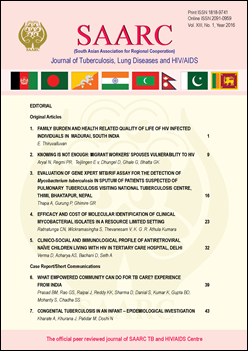Clinico-Social and Immunological Profile of Antiretroviral Naïve Children Living With HIV In Tertiary Care Hospital, Delhi
DOI:
https://doi.org/10.3126/saarctb.v13i1.16926Keywords:
AIDS, HIV, Opportunistic Infections, ImmunodeficiencyAbstract
Introduction: This study was undertaken to assess the clinical profile of children living with HIV at the time of their enrolment in an ART centre in Delhi. The study also attempts to understand association between clinical staging and immunological profile (CD4 count/percentage) in HIV infected children. The findings of this study may help policy makers to plan better health care of CLHIV in resource constrained country like India. The Objectives of the study were to assess the baseline clinico-social and immunological profile of HIV positive children before the start of Antiretroviral Therapy, to study clinicosocial and morbidity profile of HIV positive children at the time of their enrolment in ART centre and to study the association between immunodeficiency and clinical staging of CLHIV.
Methodology: The present study, conducted between December 2012 and March 2013, is a retrospective case review of 83 antiretroviral naïve Children living with HIV aged 8 months to 13 years and attending paediatric ART clinic of a tertiary care hospital of Delhi. After the infection was established on serological grounds, information on socio-demographic, clinical and immunological profile was studied.
Results: Majority (62.7%) of CLHIV were boys. Both parents of CLHIV were found to be positive in 63.9% while mother was found to be positive in 69.9%. The most common route of HIV infection was mother-to-child transmission (69.9%), followed by transmission though blood/blood products (12.0%). Every three out of four children (71.1%) were in WHO clinical stage III or IV. Three out of four (74.7%) children presented with fever, one in two with cough (56.6%). Diarrhoea (56.6%), pneumonia (41.0%), popular pruritic eruptions (18.1%), candidiasis (16.9%) and tuberculosis (14.5%) were the most common opportunistic infections in these children. The most common signs present were hepatomegaly (81.9%), anaemia (78.3%) and lymphadenopathy (72.3%).
Conclusion: Mother to child transmission is the most common route of transmission in CLHIV. At enrolment more than half of the children were in clinical stage III&IV. Fever, cough, diarrhoea, weight loss, rashes were common morbidities of the children. Majority of the children had hepatomegaly, anaemia and lymphadenopathy.
SAARC J TUBER LUNG DIS HIV/AIDS, 2016; XIII(1) p.32-38
Downloads
Downloads
Published
How to Cite
Issue
Section
License
Copyright © SAARC Tuberculosis and HIV/AIDS Centre (STAC), all rights reserved, no part of this publication may be reproduced, stored in a retrieval system or transmitted in any form or by any means without prior permission of the STAC.





